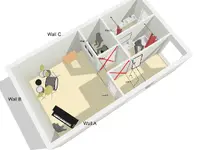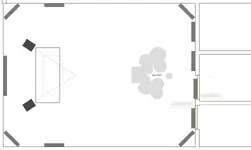r1chard
New member
I have done a little research on this subject but I would like to know from someone who has experience doing this and with the products I am contemplating using. Realize this is not a pro studio, it is for my hobby. I may have some friends come over and do some recording of live instruments if it works out. I am trying to get away without increasing cost to finish basement too much basically on a lower budget. This is what I have to work with. I designed the basement without studio in mind, now this is an afterthought and I don't want to change plans with the city. The size is a little smaller than I origionally though, 14x16 plus the little hall
Here is the room below. All walls are floating according to code. Walls A and B are concrete covered with fiberglass insulation and plastic cover. Wall C is a double wall with space to but another layer of sheet rock or something.
Walls 1 2 and 3 enclose the studio room where I would plan to do vocal work and would really be important to keep quiet. 2 bathrooms are on the other side of 3. So now I have some questions.

Below is wall C, what should I put between he walls if anything?

Below is wall A and B. They are concrete with fiberglass with plastic sheath. There is a space between the wall and the bat. Should I put something behind there and what? How do I quiet water, gas and duct noise?

Below is the ceiling, should I use batt insulation? Double 5/8s sheetrock? Zchannel or resiant channel to suspend the ceiling?

So further questioning. To everything there is a point of deminishing returns. I am trying to reduce outside sound levels, Being underground and next to dirt helps. I am wondering, Is it better to double the drywalls on walls A,B and C or suspend it using resilient channel. The drywaller has done this and knows how to make sure the screws do not go directly into stud but channel only and that the ceiling drywall does not touch a wall drywall, only drywall tape. Any suggestions would be helpful from someone who has done this before and has used different products or knows which are better. Thanks in advance.
What are some economical ways of reducing sound with little money. How do I make sure the small vocal room is best insulated from sound, how to fix the door and what type of door to use. I am going to double pane glass window, any thoughts on the best way to do that? I found some rectangular glass tables at a furnature store that had broken legs or were extras, they were extra thick and identical, I was thinking about using them, Any thoughts?


Here is the room below. All walls are floating according to code. Walls A and B are concrete covered with fiberglass insulation and plastic cover. Wall C is a double wall with space to but another layer of sheet rock or something.
Walls 1 2 and 3 enclose the studio room where I would plan to do vocal work and would really be important to keep quiet. 2 bathrooms are on the other side of 3. So now I have some questions.

Below is wall C, what should I put between he walls if anything?

Below is wall A and B. They are concrete with fiberglass with plastic sheath. There is a space between the wall and the bat. Should I put something behind there and what? How do I quiet water, gas and duct noise?

Below is the ceiling, should I use batt insulation? Double 5/8s sheetrock? Zchannel or resiant channel to suspend the ceiling?

So further questioning. To everything there is a point of deminishing returns. I am trying to reduce outside sound levels, Being underground and next to dirt helps. I am wondering, Is it better to double the drywalls on walls A,B and C or suspend it using resilient channel. The drywaller has done this and knows how to make sure the screws do not go directly into stud but channel only and that the ceiling drywall does not touch a wall drywall, only drywall tape. Any suggestions would be helpful from someone who has done this before and has used different products or knows which are better. Thanks in advance.
What are some economical ways of reducing sound with little money. How do I make sure the small vocal room is best insulated from sound, how to fix the door and what type of door to use. I am going to double pane glass window, any thoughts on the best way to do that? I found some rectangular glass tables at a furnature store that had broken legs or were extras, they were extra thick and identical, I was thinking about using them, Any thoughts?


Last edited:










